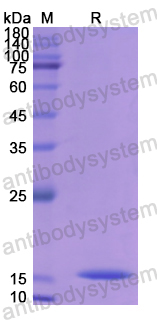Catalog No.
YHB90301
Expression system
E. coli
Species
Homo sapiens (Human)
Protein length
Ser21-Ala141
Predicted molecular weight
16.50 kDa
Nature
Recombinant
Endotoxin level
Please contact with the lab for this information.
Purity
>90% as determined by SDS-PAGE.
Accession
P01036
Applications
ELISA, Immunogen, SDS-PAGE, WB, Bioactivity testing in progress
Form
Lyophilized
Storage buffer
Lyophilized from a solution in PBS pH 7.4, 0.02% NLS, 1mM EDTA, 4% Trehalose, 1% Mannitol.
Reconstitution
Reconstitute in sterile water for a stock solution. A copy of datasheet will be provided with the products, please refer to it for details.
Shipping
In general, proteins are provided as lyophilized powder/frozen liquid. They are shipped out with dry ice/blue ice unless customers require otherwise.
Stability and Storage
Use a manual defrost freezer and avoid repeated freeze thaw cycles. Store at 2 to 8°C for frequent use. Store at -20 to -80°C for twelve months from the date of receipt.
Alternative Names
Cystatin-4, CST4, Salivary acidic protein 1, Cystatin-S, Cystatin-SA-III
Serum Cystatin S (CST4): A Novel Prognostic Marker for Gastric Cancer., PMID:39776666
Comparative analysis of electrophoresis and interferometric optical detection method for molecular weight determination of proteins., PMID:39229532
Cysteine protease inhibitor S promotes lymph node metastasis of esophageal cancer cells via VEGF-MAPK/ERK-MMP9/2 pathway., PMID:38386044
Investigating the prognostic and predictive value of the type II cystatin genes in gastric cancer., PMID:37978366
Analysis of IGHA1 and other salivary proteins post half marathon in female participants., PMID:37193030
The Diagnosis Significance of Serum Cysteine Protease Inhibitors (CST4) in Colorectal Cancer., PMID:37122229
Salivary Proteomics Markers for Preclinical Sjögren's Syndrome: A Pilot Study., PMID:35740863
Combination of serum CST4 and DR-70 contributes to early diagnosis of colorectal cancer., PMID:35500878
mRNA-miRNA bipartite networks reconstruction in different tissues of bladder cancer based on gene co-expression network analysis., PMID:35393513
Development and Evaluation of Serum CST1 Detection for Early Diagnosis of Esophageal Squamous Cell Carcinoma., PMID:34764696
Quantification of a panel for dry-eye protein biomarkers in tears: A comparative pilot study using standard ELISA and customized microarrays., PMID:34012227
Prognostic value of immune-related cells and genes in the tumor microenvironment of ovarian cancer, especially CST4., PMID:33811900
Changes in tear biomarker levels in keratoconus after corneal collagen crosslinking., PMID:30804658
Functional and genomic characterisation of a xenograft model system for the study of metastasis in triple-negative breast cancer., PMID:29720474
Antibody-sandwich ELISA analysis of a novel blood biomarker of CST4 in gastrointestinal cancers., PMID:29636621
Tear proteome analysis in ocular surface diseases using label-free LC-MS/MS and multiplexed-microarray biomarker validation., PMID:29234088
Multitissue Transcriptomics Delineates the Diversity of Airway T Cell Functions in Asthma., PMID:28933920
Redox theory of aging: implications for health and disease., PMID:28667066
Antigen-Antibody Affinity for Dry Eye Biomarkers by Label Free Biosensing. Comparison with the ELISA Technique., PMID:26287192
Interindividual variation, correlations, and sex-related differences in the salivary biochemistry of young healthy adults., PMID:25809904
Evolution of C, D and S-type cystatins in mammals: an extensive gene duplication in primates., PMID:25329717
Differential profiles of salivary proteins with affinity to Streptococcus mutans lipoteichoic acid in caries-free and caries-positive human subjects., PMID:24848678
Tear proteome and protein network analyses reveal a novel pentamarker panel for tear film characterization in dry eye and meibomian gland dysfunction., PMID:23201116
Proteomics of tear fluid in thyroid-associated orbitopathy., PMID:22873942
Global secretome analysis identifies novel mediators of bone metastasis., PMID:22688892
Protein and mucin retention on oral mucosal surfaces in dry mouth patients., PMID:20572857
Extracellular production of human cystatin S and cystatin SA by Bacillus subtilis., PMID:16737825
Two-dimensional electrophoresis study of in vitro pellicle formation and dental caries susceptibility., PMID:16630307
Innate secretory immunity in response to laboratory stressors that evoke distinct patterns of cardiac autonomic activity., PMID:12651992
Salivary (SD-type) cystatins: over one billion years in the making--but to what purpose?, PMID:12499242
Expression of type 2 cystatin genes CST1-CST5 in adult human tissues and the developing submandibular gland., PMID:11879580
Autonomic regulation of cystatin S gene expression in rat submandibular glands., PMID:11023628
Functional aspects of the human salivary cystatins in the oral environment., PMID:10483070
Examination of the potential structure of human salivary cystatins based on computer modelling., PMID:9447266
Cystatin A in gingival crevicular fluid of periodontal patients., PMID:9401930
The cystatin S gene maps to rat chromosome 3, to which D1mgh18 is re-assigned from chromosome 1., PMID:9383294
Inhibition of the growth and cysteine proteinase activity of Porphyromonas gingivalis by human salivary cystatin S and chicken cystatin., PMID:8997496
Growth inhibition of a human oral bacterium Porphyromonas gingivalis by rat cysteine proteinase inhibitor cystatin S., PMID:8862019
Human glandular salivas: their separate collection and analysis., PMID:8930581
Analysis of the concentration and output of whole salivary constituents in patients with Sjögren's syndrome., PMID:8930579
Salivary protein composition in epileptic patients on different medications., PMID:8890049
Effect of periodontal treatment on the protein composition of whole and parotid saliva., PMID:8708950
Bactericidal effect of rat cystatin S on an oral bacterium Porphyromonas gingivalis., PMID:7749605
Production of human salivary type cysteine proteinase inhibitors (cystatins) by an Escherichia coli system and partial characterization of recombinant cystatin S and its mutant (117 arginine-->tryptophan)., PMID:7822260
Genetic polymorphisms of the CST2 locus coding for cystatin SA., PMID:8034293
Structure, organization and regulation of a rat cysteine proteinase inhibitor-encoding gene., PMID:1537554
Characterization of two members (CST4 and CST5) of the cystatin gene family and molecular evolution of cystatin genes., PMID:1334620
Structure and expression of the gene encoding cystatin D, a novel human cysteine proteinase inhibitor., PMID:1939105
Identification of full-sized forms of salivary (S-type) cystatins (cystatin SN, cystatin SA, cystatin S, and two phosphorylated forms of cystatin S) in human whole saliva and determination of phosphorylation sites of cystatin S., PMID:1778989
Salivary cystatin SA-III, a potential precursor of the acquired enamel pellicle, is phosphorylated at both its amino- and carboxyl-terminal regions., PMID:1898055

